Forklift vertical lift is a widely used material vertical transportation equipment with the advantages of compact structure, strong carrying capacity and smooth operation. It is widely used in industrial manufacturing, warehousing logistics, floor distribution, automated stereoscopic warehouse and other scenarios. The operating performance of the equipment is not only affected by the mechanical, electrical and hydraulic systems, but also closely related to the external environmental conditions. Among them, the ambient temperature is one of the key factors affecting the operating stability, service life and safety performance of the equipment.
The performance of the hydraulic system is significantly affected by temperature fluctuations
The hydraulic system is the core power source of the forklift vertical lift. High or low temperature environment will directly affect the viscosity of the hydraulic oil and the reaction speed of the system.
Under low temperature conditions, the viscosity of the hydraulic oil increases, the fluidity deteriorates, and the starting resistance of the oil pump increases, which can easily cause the system to start difficultly, slow or even unable to start.
High viscosity will also cause the pressure in the hydraulic pipeline to increase, and it is easy to cause faults such as oil pipe rupture and sealing ring damage, shortening the service life of hydraulic components.
Under high temperature environment, the viscosity of the hydraulic oil decreases, the lubrication performance decreases, and it is easy to cause increased internal leakage, decreased cylinder thrust, and weakened lifting capacity.
Long-term high temperature will also accelerate the oxidation of hydraulic oil, forming sludge and sediment, blocking the valve body and oil circuit, and affecting the system response and control accuracy.
In extremely high temperature environments, the aging speed of the seals in the oil cylinder is accelerated, resulting in seal failure, oil leakage or unstable system pressure.

The stability of the electrical control system decreases under abnormal temperature
The electrical control system is sensitive to temperature changes, which is directly related to the control accuracy and safety protection capabilities of the whole machine.
In low temperature environments, the working response time of some electrical components such as contactors, relays and sensors slows down, and startup delays or malfunctions may occur.
Low temperature causes the capacity of battery-type components (such as UPS power supplies) to decrease, and the control system is prone to restart or loss of control due to insufficient voltage.
High temperature environments increase the internal temperature of the electric control cabinet, which may cause overheating of components such as PLC, inverter, power module, and frequent alarms, frequency reduction operation or fault shutdown.
Long-term high temperature operation will cause the cable insulation layer to age, the terminal block to oxidize and loosen, and increase the risk of electrical short circuit or fire.
In high temperature and high humidity environments, the control board is prone to condensation or moisture absorption, causing circuit board corrosion or circuit short circuit, affecting the stability of the control system.
The risk of deformation of mechanical structures increases under extreme temperature conditions
The thermal expansion and contraction effects of mechanical parts are more significant under extreme temperature conditions, which have a certain degree of impact on the overall structure of the equipment.
Under high temperature conditions, the expansion of metal structures such as guide rails, platforms, and fork arms may cause a decrease in guiding accuracy, and slight jamming or shaking during platform operation.
In extremely cold environments, metals become brittle and their impact resistance decreases. When encountering instantaneous loads, microcracks or weld cracks are prone to occur.
Components of different materials (such as steel structures and rubber parts) have different thermal expansion coefficients, and temperature changes cause loosening of connections or failure of preload.
Long-term exposure of platforms in high temperature environments is prone to coating aging and color difference changes, reducing the appearance and anti-corrosion performance of the equipment.
The efficiency of the lubrication system is significantly affected by the temperature
The protection of moving parts by the lubrication system depends on the fluidity and adhesion of the lubricant, and these two indicators are strongly affected by temperature fluctuations.
Under low temperature conditions, the viscosity of lubricating oil increases, the friction resistance between moving parts such as bearings and slide rails increases, and the start-up wear increases significantly.
Under high temperature conditions, lubricating oil is easy to lose or evaporate, forming a dry friction state, aggravating component wear and shortening service life.
Grease is easy to emulsify or decompose under high temperature conditions, forming sediments to block the lubrication channel, resulting in lubrication failure.
In an environment with frequent alternation of hot and cold, the oxidation of lubricating oil is accelerated. It is recommended to use industrial special lubricating oil with temperature difference resistance.










 Español
Español















